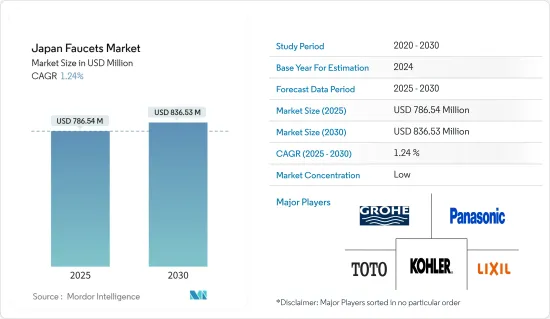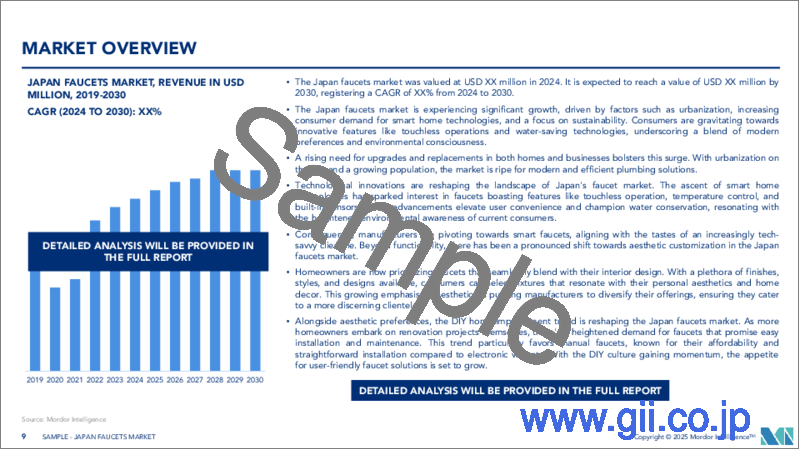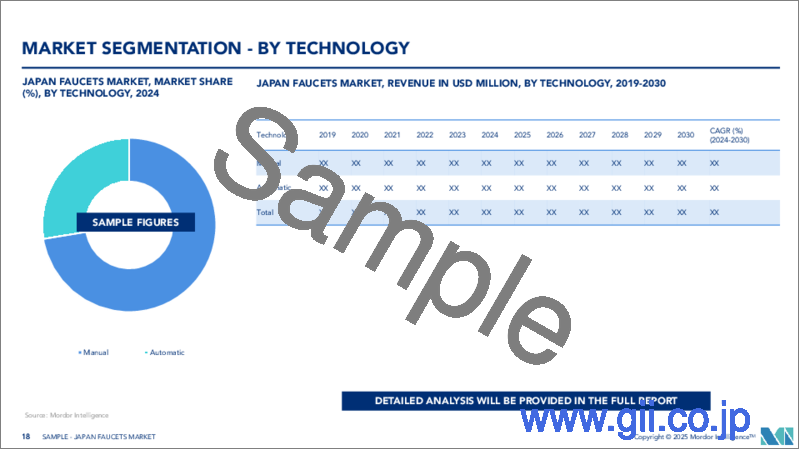|
|
市場調査レポート
商品コード
1694019
日本の水栓:市場シェア分析、産業動向・統計、成長予測(2025~2030年)Japan Faucets - Market Share Analysis, Industry Trends & Statistics, Growth Forecasts (2025 - 2030) |
||||||
カスタマイズ可能
適宜更新あり
|
|||||||
| 日本の水栓:市場シェア分析、産業動向・統計、成長予測(2025~2030年) |
|
出版日: 2025年03月18日
発行: Mordor Intelligence
ページ情報: 英文 120 Pages
納期: 2~3営業日
|
全表示
- 概要
- 目次
日本の水栓市場規模は2025年に7億8,654万米ドルと推定・予測され、2030年には8億3,653万米ドルに達すると予測され、予測期間(2025~2030年)のCAGRは1.24%です。

日本の水栓市場は、長年にわたって着実な成長を遂げている盛んな産業です。日本は品質、技術革新、節水を強く重視しており、先進的水栓技術の拠点となっています。市場の主要促進要因のひとつは、建設・リフォームセグメントです。日本では建設産業が盛んで、住宅、商業、インフラプロジェクトで水栓への需要が絶え間なく高まっています。新規設置、交換、アップグレードのニーズがこの需要を促進しています。消費者の嗜好やライフスタイルの変化も市場に影響を与えています。都市化と工業化により、耐久性があり、実用的で、見た目も美しい水栓のニーズが高まっています。近代的な機能、エコフレンドリー材料、エレガントなデザインは、日本の消費者が水栓に求めるものです。
日本では水資源が限られているため、節水が優先課題となっており、水の浪費を最小限に抑えるように設計された水栓が重視されています。これには、流量が少ない水栓や、水の使用量をより効率的に制御するセンサの開発が含まれます。日本には、水の使用と製品規格を管理する厳しい環境規制があります。水栓メーカーはこうした規制を遵守しなければならず、節水技術やエコフレンドリー材料の技術革新を推進することが多いです。
日本の水栓市場動向
拡大する建設・リフォーム部門が市場需要を後押し
住宅、商業施設、インフラプロジェクトに必要な水栓の需要は、主に日本の建設・リフォーム部門が牽引しています。建設プロジェクトの数が増加するにつれて、人口増加、都市化、近代的な設備へのニーズによって、新規設置、交換、水栓のアップグレードのニーズも増加します。新しい建築設計や材料が登場するにつれ、水栓メーカーは変化する同セグメントの需要に対応するために技術革新を行う必要があります。
日本の建築・リフォーム産業は、節水を含むサステイナブル建築プラクティスを優先しています。この強調は、環境の持続可能性に対する日本のコミットメントと一致しています。水栓メーカーは、節水型エアレーター、センサ付き水栓、効率的な流量制限装置など、エコフレンドリー機能を導入することで、この需要に応えています。サステイナブル実践に重点を置く同部門は、建設プロジェクトにおけるこうした水栓の採用を後押ししています。全体として、建設・リフォーム部門は日本の水栓市場における需要、技術革新、製品提供を形成する上で重要な役割を果たしています。
技術進歩の高まりが市場を後押し
日本の水栓市場は近年著しい技術進歩を遂げ、産業に革命をもたらしました。これらの進歩は、機能性、利便性、持続可能性の向上を含む数多くの利点をもたらしています。日本の水栓市場における大きな進歩のひとつは、タッチレス操作です。タッチレス水栓またはセンサ式水栓は、赤外線センサが手の動きを検知し、自動的に水流を作動させるため、二次汚染のリスクを低減し、衛生を促進します。これらの水栓は、利便性と使いやすさを提供し、公共トイレや家庭で人気が高まっています。
節水もまた、日本の水栓市場で大きな技術進歩を遂げたセグメントのひとつです。多くの水栓は現在、流量制限器、エアレーター、スマート節水システムを備え、水流を調整し、性能を損なうことなく無駄を最小限に抑えています。こうした技術は、環境の持続可能性を重視する日本の姿勢に合致しており、消費者の水道料金節約に役立っています。抗菌コーティングも日本の水栓市場で普及しており、水栓表面でのバクテリアやその他の微生物の増殖を抑制し、汚染のリスクを低減し、清潔さを促進します。継続的な研究と技術革新により、市場はさらに高度で効率的な水栓オプションを目にすることになると考えられます。
日本の水栓産業概要
日本の水栓市場は競争が激しく、国内メーカーと国際ブランドの両方が市場シェアを争っています。TOTO、LIXILグループ、パナソニック、グローエ、コーラーが主要企業です。これらの企業は、市場の需要拡大に対応するため、製品のイノベーションに投資し、流通チャネルを拡大しています。
その他の特典
- エクセル形式の市場予測(ME)シート
- 3ヶ月間のアナリストサポート
目次
第1章 イントロダクション
- 調査の前提条件と市場定義
- 調査範囲
第2章 調査手法
第3章 エグゼクティブサマリー
第4章 市場力学と洞察
- 市場概要
- 市場の促進要因
- 建設・改築活動の活発化
- 節水と持続可能性への意識の高まり
- 市場抑制要因
- スマート水栓ソリューションに関連する高コスト
- 国内外のメーカー間の激しい競合
- 市場機会
- スマート水栓の採用
- 建設会社や建築家とのコラボレーション
- バリューチェーン分析
- 産業の魅力ポーターのファイブフォース分析
- 新規参入業者の脅威
- 買い手の交渉力
- 供給企業の交渉力
- 代替品の脅威
- 競争企業間の敵対関係
- 産業の技術的進歩に関する洞察
- COVID-19の市場への影響
第5章 市場セグメンテーション
- 製品タイプ別
- ボール
- ディスク
- カートリッジ
- コンプレッション
- 技術別
- 手動
- 自動
- 使用材料別
- クロム
- ステンレス
- 真鍮
- ポリテトラメチレンテレフタレート(PTMT)プラスチック
- その他
- 用途別
- 浴室用水栓
- キッチン用水栓
- エンドユーザー別
- 住宅用
- 業務用
- 設置タイプ別
- 壁付け
- デッキマウント
第6章 競合情勢
- 市場集中度概要
- 企業プロファイル
- TOTO
- LIXIL Group
- Panasonic
- Grohe
- Kohler
- Delta Faucet Company
- Moen Incorporated
- Pfister
- INAX
- Hansgrohe*
第7章 今後の市場動向
第8章 免責事項と出版社について
The Japan Faucets Market size is estimated at USD 786.54 million in 2025, and is expected to reach USD 836.53 million by 2030, at a CAGR of 1.24% during the forecast period (2025-2030).

The Japanese faucets market in is a thriving industry that has witnessed steady growth over the years. Japan strongly emphasizes quality, innovation, and water conservation and has become a hub for advanced faucet technologies. One of the key drivers of the market is the construction and renovation sector. Japan has a robust construction industry, constantly demanding faucets in residential, commercial, and infrastructure projects. The need for new installations, replacements, and upgrades fuels this demand. The shifting preferences and lifestyles of consumers have an impact on the market as well. The need for durable, practical, and visually beautiful faucets has grown because of urbanization and industrialization. Modern features, eco-friendly materials, and elegant designs are what Japanese consumers look for in faucets.
With water conservation being a priority in Japan due to the country's limited water resources, there is a strong emphasis on faucets designed to minimize water wastage. This includes the development of faucets with low flow rates and sensors that control water usage more efficiently. Japan has strict environmental regulations governing water usage and product standards. Faucet manufacturers must comply with these regulations, often driving innovation in water-saving technologies and eco-friendly materials.
Japan Faucets Market Trends
Expanding Construction and Renovation Sector Fueling the Market Demand
The demand for faucets, which are necessary for residential, commercial, and infrastructure projects, is primarily driven by Japan's construction and renovation sector. As the number of construction projects rises, so does the need for new installations, replacements, and faucet upgrades, driven by the growing population, urbanization, and the need for modern amenities. As new building designs and materials emerge, faucet manufacturers need to innovate to meet the changing demands of the sector.
The Japanese construction and renovation sector prioritizes sustainable building practices, including water conservation. This emphasis aligns with the country's commitment to environmental sustainability. Faucet manufacturers respond to this demand by introducing eco-friendly features such as water-saving aerators, sensor-activated faucets, and efficient flow restrictors. The sector's focus on sustainable practices drives the adoption of such faucets in construction projects. Overall, the construction and renovation sector plays a vital role in shaping the demand, innovation, and product offerings within the Japanese faucet market.
Rising Technological Advancements Boosting the Market
The Japanese faucets market has undergone significant technological advancements in recent years, with innovations that have revolutionized the industry. These advancements have brought numerous benefits, including improved functionality, convenience, and sustainability. One of the major advancements in the Japanese faucets market is touchless operation. Touchless or sensor-activated faucets use infrared sensors to detect hand movements and automatically activate the water flow, reducing the risk of cross-contamination and promoting hygiene. These faucets are increasingly popular in public restrooms and homes, offering convenience and ease of use.
Water conservation is another area that has seen significant technological advancements in the Japanese faucets market. Many faucets now feature flow restrictors, aerators, and smart water-saving systems that regulate water flow and minimize wastage without compromising performance. These technologies align with Japan's focus on environmental sustainability and help consumers save on water bills. Anti-bacterial coatings have also become popular in the Japanese faucet market, inhibiting the growth of bacteria and other microbes on the faucet surfaces, reducing the risk of contamination, and promoting cleanliness. With ongoing research and innovation, the market is likely to see even more advanced and efficient faucet options.
Japan Faucets Industry Overview
The Japanese faucets market is competitive, with both domestic manufacturers and international brands vying for market share. TOTO, LIXIL Group, Panasonic, Grohe, and Kohler are key players. These companies are investing in product innovation and expanding their distribution channels to cater to the market's growing demand.
Additional Benefits:
- The market estimate (ME) sheet in Excel format
- 3 months of analyst support
TABLE OF CONTENTS
1 INTRODUCTION
- 1.1 Study Assumptions and Market Definition
- 1.2 Scope of the Study
2 RESEARCH METHODOLOGY
3 EXECUTIVE SUMMARY
4 MARKET DYNAMICS AND INSIGHTS
- 4.1 Market Overview
- 4.2 Market Drivers
- 4.2.1 Rising Construction and Renovation Activities
- 4.2.2 Increasing Awareness of Water Conservation and Sustainability
- 4.3 Market Restraints
- 4.3.1 High Cost Associated with Smart Faucets Solutions
- 4.3.2 Intense Competition among Domestic and International Manufacturers
- 4.4 Market Opportunities
- 4.4.1 Adoption of Smart Faucets
- 4.4.2 Collaborations with Construction Companies and Architects
- 4.5 Value Chain Analysis
- 4.6 Industry Attractiveness: Porter's Five Forces Analysis
- 4.6.1 Threat of New Entrants
- 4.6.2 Bargaining Power of Buyers
- 4.6.3 Bargaining Power of Suppliers
- 4.6.4 Threat of Substitutes
- 4.6.5 Intensity of Competitive Rivalry
- 4.7 Insights into Technological Advancements in the Industry
- 4.8 Impact of COVID-19 on the Market
5 MARKET SEGMENTATION
- 5.1 By Product Type
- 5.1.1 Ball
- 5.1.2 Disc
- 5.1.3 Cartridge
- 5.1.4 Compression
- 5.2 By Technology
- 5.2.1 Manual
- 5.2.2 Automatic
- 5.3 By Material Used
- 5.3.1 Chrome
- 5.3.2 Stainless Steel
- 5.3.3 Brass
- 5.3.4 Polytetra Methylene Terephthalate (PTMT) Plastic
- 5.3.5 Other Materials
- 5.4 By Application
- 5.4.1 Bathroom Faucets
- 5.4.2 Kitchen Faucets
- 5.5 By End User
- 5.5.1 Residential
- 5.5.2 Commercial
- 5.6 By Installation Type
- 5.6.1 Wall Mount
- 5.6.2 Deck Mount
6 COMPETITIVE LANDSCAPE
- 6.1 Market Concentration Overview
- 6.2 Company Profiles
- 6.2.1 TOTO
- 6.2.2 LIXIL Group
- 6.2.3 Panasonic
- 6.2.4 Grohe
- 6.2.5 Kohler
- 6.2.6 Delta Faucet Company
- 6.2.7 Moen Incorporated
- 6.2.8 Pfister
- 6.2.9 INAX
- 6.2.10 Hansgrohe*





